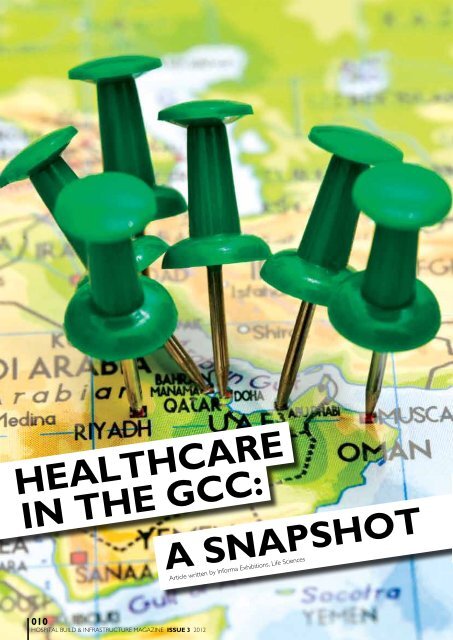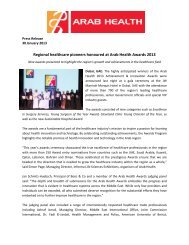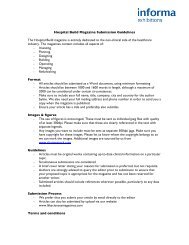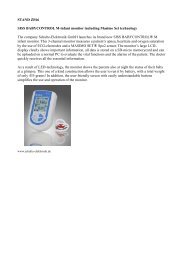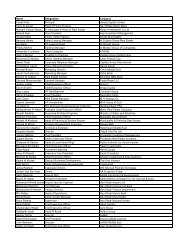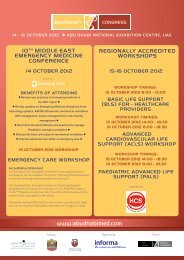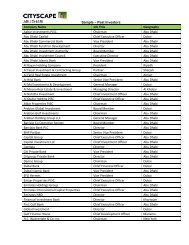HEALTHCARE IN THE GCC: A SNAPSHOT - IIR Middle East
HEALTHCARE IN THE GCC: A SNAPSHOT - IIR Middle East
HEALTHCARE IN THE GCC: A SNAPSHOT - IIR Middle East
You also want an ePaper? Increase the reach of your titles
YUMPU automatically turns print PDFs into web optimized ePapers that Google loves.
Healthcare<br />
in the <strong>GCC</strong>:<br />
a snapshot<br />
Article written by Informa Exhibitions, Life Sciences<br />
010<br />
HOSPITAL BUILD & <strong>IN</strong>FRASTRUCTURE magazine issue 3 2012
<strong>SNAPSHOT</strong> <strong>GCC</strong><br />
011<br />
The GGC <strong>HEALTHCARE</strong> market<br />
While markets across the globe and the Gulf were facing troubled economic<br />
times, the <strong>GCC</strong> member states (UAE, Saudi Arabia, Qatar, Bahrain, and<br />
Oman) has witnessed a shift in the profile of the healthcare market. An<br />
ageing population, rapid urbanisation and lifestyle diseases such as diabetes,<br />
cardiovascular problems and obesity are on the rise in the Gulf and through<br />
the oil-driven economic boom, increased disposable incomes and spending<br />
also increase the demand for healthcare services. In 2007, McKinsey and Co.<br />
calculated the <strong>GCC</strong> healthcare expenditure to reach a total of US$60 billion<br />
by 2025; most probably an underestimate considering how both the Kuwaiti<br />
and Saudi healthcare budgets, for example, are growing.<br />
The <strong>GCC</strong> healthcare market is projected to grow at an annual rate<br />
of 11% by 2015 with Saudi Arabia and UAE being the fastest growing<br />
markets. The demand for the number of hospital beds is expected<br />
to be 93,992 in 2015, a more than 10% increase in beds from 2010.<br />
This is in line with the current <strong>GCC</strong> average but below the US and<br />
European numbers. The demand is also down to the increasing<br />
insurance penetration in the <strong>GCC</strong>, which will result in an increase of<br />
patients opting to stay in their home country for treatment, leading<br />
to a higher demand in hospital beds. At the moment, due to the lack<br />
of beds and qualified healthcare professionals, some <strong>GCC</strong> countries<br />
send as many as 10% of all inpatients abroad for emergency care.<br />
For example, in 2009 alone, the UAE spent US$2 billion on overseas<br />
medical treatment for its citizens. Turn to page 12 to read more about<br />
the specific <strong>GCC</strong> countries and their plans for the future.<br />
Healthcare challenges in the region<br />
Healthcare standards in the <strong>GCC</strong> are constantly improving. Factors such as<br />
infant mortality and life expectancy at birth continue to improve, but the<br />
main issue behind the increase in <strong>GCC</strong> healthcare costs, is the sedentary and<br />
unhealthy lifestyle many people in the <strong>Middle</strong> <strong>East</strong> live. The <strong>GCC</strong> is widely<br />
recognised as one of the most obese regions in the world, with close to two<br />
thirds of the entire adult population of the <strong>Middle</strong> <strong>East</strong> being overweight.<br />
Recent studies suggest that obesity is more expensive to the healthcare<br />
system than smoking, with obese patients tending to spend 2-3 times as<br />
much as the average patient on healthcare. The link between obesity and<br />
type 2 diabetes is also evident by the high percentage of adults in the <strong>GCC</strong><br />
that suffer from type 2 diabetes. Saudi Arabia has the fourth highest rate of<br />
diabetes globally at about 22%, while Kuwait and the UAE are also in the<br />
top 20. A type 2 diabetes patient is four times more likely to be hospitalised,<br />
equalling a huge burden on health budgets. In the UAE for example, chronic<br />
lifestyle diseases and injuries cause almost 90% of all deaths.<br />
The shortage of medical professionals is another major problem in<br />
the <strong>GCC</strong>. There are very limited medical education options in the region<br />
and healthcare organisations depend on expatriates, which accounts to<br />
40-80% of the total workforce. Currently around 20 qualified physicians<br />
serve every 10,000 people, compared to approximately 27 doctors in<br />
the US and UK systems indicating a shortage of about 180,000 specialists.<br />
According to WHO, the MENA region has 3.5 dentistry staff and 28.4<br />
nurses per 10,000 people, which is nearly 79% and 71% respectively<br />
lower compared to the US. Another issue contributing to the rise<br />
in healthcare cost in the the <strong>GCC</strong> is the increasing use of new and<br />
advanced technologies because of education, health awareness and also<br />
the rising affluence of the population. Studies reveal that the use of new<br />
medical technologies can increase healthcare costs by 38-62% and is<br />
often not covered by insurance providers.<br />
More info<br />
Hospital Build & Infrastructure is now a global brand with shows taking place<br />
in Asia, China, Europe, India, Turkey, Russia and the <strong>Middle</strong> <strong>East</strong>. For more<br />
information on each of the events, please visit www.hospitalbuild.com<br />
WAYS TO REDUCE <strong>HEALTHCARE</strong> COSTS<br />
Accountable Care Models<br />
Accountable Care Models are being tested across the <strong>GCC</strong><br />
to help reduce healthcare costs. Dr Al Razouki, CEO of Kleos<br />
Healthcare Corporation in Kuwait explains: “Certain clinical centres<br />
of excellence in Saudi Arabia are piloting an interesting initiative<br />
whereby physicians are actually made aware of the costs of<br />
procedures and prescriptions before prescribing their treatment to<br />
their patients through a computerised physician order entry (CPOE)<br />
system that prints out the associated cost of the procedure or<br />
prescription. This has a dual effect: A) physicians are less likely<br />
to prescribe useless tests and psychological placebo medications,<br />
thereby reducing the cost burden on their respective department<br />
and B) patients, who do not even pay a simple co-payment and<br />
are used to receiving both the treatment and prescription for free,<br />
are made aware of the ‘value’ of the service the government is<br />
providing them”.<br />
The PPP’s<br />
With governments in the <strong>Middle</strong> <strong>East</strong> struggling to keep up with the<br />
unsustainable demand on healthcare, can Public Private Partnerships<br />
(PPP) help ease the burden? “We are witnessing governments in<br />
the <strong>GCC</strong> focus more and more on the healthcare industry in their<br />
respective countries, improving structure and facilities. However,<br />
governments are facing many challenges in doing so, with many<br />
turning towards PPP, to aid in the transfer of quality service to<br />
raise the level of healthcare provision across the region”, said Julian<br />
Hawkins, Partner in Charge for Consulting Services at Deloitte <strong>Middle</strong><br />
<strong>East</strong>, knowledge partners of the 2012 edition of Hospital Build &<br />
Infrastructure <strong>Middle</strong> <strong>East</strong>. A successful PPP has been proven to<br />
save governments as much as 25% on healthcare costs. In the UAE<br />
for example, where the government is still footing 70% of the total<br />
healthcare cost, has been encouraging the participation of the private<br />
sector and development of PPPs in order to develop both hard and<br />
soft infrastructure. Abu Dhabi is a driving force in the development<br />
of PPP’s and is based on management partnerships with some<br />
major international hospitals such as Varned, Cleveland Clinic, Johns<br />
Hopkins and Bumrungrad.<br />
WHAT NEXT?<br />
In order for the medical industry to flourish in the <strong>GCC</strong>, the healthcare<br />
infrastructure must be improved through a regulatory structure, the<br />
development of strategies to attract and retain professionals, as well as<br />
writing action plans for the development of facilities. “Governments in<br />
the <strong>GCC</strong> should play a more pivotal role in the healthcare sector, to<br />
enhance its reach and services in their respective countries”, said Mr<br />
Hawkins. “In addition, there is a growing need for augmented medical<br />
facilities and improved medical insurance, for a stronger healthcare<br />
market. Public Private Partnerships will surely aid in the development of<br />
the sector”, he added.<br />
In short<br />
• Complications due to lifestyle diseases cause huge financial and<br />
social burden on an already over-stretched healthcare system<br />
• Public Private Partnerships are used to help ease some of the<br />
financial burden on <strong>GCC</strong> goverments<br />
• The acute lack of qualified medical staff is a worry in the region,<br />
with some professions lacking 70% in numbers compared to the<br />
West.<br />
www.lifesciencesmagazines.com
Hospital build & infrastructure exhibition and congress 2012<br />
On June 4 th this year, His Excellency Abdul Rahman Mohammed Al Owais, Minister of Culture, Youth and Community Development and the<br />
Acting Minister of Health officially inaugurated the 4 th edition of Hospital Build & Infrastructure <strong>Middle</strong> <strong>East</strong> Exhibition & Congress. The event<br />
is the only one in the region dedicated to bringing investors, commissioners, backers and managers of major healthcare projects together<br />
with the suppliers of the best services in architecture, planning, design, construction, operations, management, and refurbishment under one<br />
roof. This year, the show experienced a 30% increase in exhibitors from 2011 with 86% of the exhibitors agreeing that Hospital Build &<br />
Infrastructure <strong>Middle</strong> <strong>East</strong> is very important for their marketing activities in the region. Over the course of the three days of the show, more<br />
than 5,000 visitors walked through the doors with the majority looking to get some general information and to keep up-to-date with new<br />
products or trends in the region. A quarter of all visitors also took the opportunity to meet up with their existing suppliers.<br />
In addition to the 7,560sqm exhibition, eight successful conferences took place over the three days covering topics such as: Hospital<br />
Design & Upgrade, Leaders in Healthcare, Imaging & Diagnostic Management, m + Health, Surgery Management, Healthcare Management,<br />
Quality, Standards & Accreditation in Healthcare and the new Architect’s Congress. Highly regarded industry professionals shared their<br />
knowledge at the conference that saw more than 600 delegates taking part.<br />
Kuwait<br />
The Kuwaiti Ministry of Health has recently announced a budget of US$4<br />
billion for 2012-13, a 100% increase from the US$2 billion budget five<br />
years ago. This accounts for more than 80% of the healthcare spending<br />
in the country. The government is currently operating 15 general and<br />
specialised hospitals with the private sector expected to grow moderately<br />
in the coming years. Private companies are estimated to take a share of 15-<br />
20% of the healthcare spend, but due to the global economic downturn,<br />
investment in the sector has been affected to some extent. Currently,<br />
Kuwait has 19 hospital beds per 10,000 people, an undersupply of serious<br />
concern given the population growth and the growing disease burden.<br />
Although the population is young on average, obesity and related chronic<br />
diseases is a huge issue in this small country. For example, obesity levels<br />
have reached 80% in women and 70% in men. In January 2011 it was<br />
announced that the government was working on a strategy to bolster the<br />
healthcare system with 3,500 beds, new laboratory- and surgical facilities.<br />
Kingdom of Saudi Arabia<br />
Saudi Arabia is the largest healthcare market in the <strong>Middle</strong> <strong>East</strong>. The Ministry of Health is<br />
responsible for close to 75% of healthcare services, with a budget this year of US$13.5 billion<br />
not including a further US$4.3 billion for the large healthcare cities projects spread across the<br />
Kingdom. This results in a grand total of approximately US$18 billion in Saudi healthcare spend.<br />
If you add another 25% for other healthcare providers, both government and private, the total<br />
Saudi healthcare budget is approx US$21.3 billion for 2012-13. At the moment, the MoH owns<br />
and operates 60% of all hospitals in the Kingdom, but KSA is an attractive market for healthcare<br />
investors due to the rapid growth in market size, the demand for hospital beds, with a young,<br />
affluent population suffering from lifestyle diseases. Aided by a large budget surplus, the public<br />
sector is set to make large investments to support healthcare provisions and complimentary<br />
sectors such as scientific research. These kinds of investments will require strong Public Private<br />
Partnerships and a strong private sector presence overall. Despite the heavy investment in the<br />
healthcare sector, compared to the West, Saudi Arabia demonstrates a severe lack of doctors,<br />
nurses and hospital beds with the lowest numbers per population within the <strong>GCC</strong>.<br />
012<br />
HOSPITAL BUILD & <strong>IN</strong>FRASTRUCTURE magazine issue 3 2012
<strong>SNAPSHOT</strong> <strong>GCC</strong><br />
013<br />
Bahrain<br />
The healthcare market in Bahrain has been witnessing robust<br />
growth over the past few years. With the recent troubles in<br />
Bahrain, the local authorities has realised that money must be<br />
spent on basic infrastructure such as healthcare to ease the<br />
demands of the growing and ageing population. In the next five<br />
years, the demand for the number of hospital beds is expected<br />
to expand to 2,367 from an estimated 2,167, a CAGR increase<br />
of almost 2%. Healthcare in Bahrain is mainly provided by the<br />
Ministry of Health public facilities. Projects, such as the King<br />
Hamad General Hospital and the construction of a one-of-a-kind<br />
health island, are expected to improve healthcare infrastructure as<br />
well as boost medical tourism in the country.<br />
Qatar<br />
The healthcare system in Qatar is set to undergo major<br />
development in the coming years. With the healthcare market<br />
expected to expand at a CAGR of 8.4% between 2010-2015 to<br />
US$3.2 billion, up from an estimated US$2.2 billion. Qatar has<br />
the highest per capita healthcare spending in the <strong>GCC</strong>. Currently,<br />
35 healthcare programmes, ranging from a mandatory healthcare<br />
insurance scheme to the configuration of hospital services, are<br />
in the pipeline. The main reason for the increasing demand on<br />
the healthcare system in Qatar is the rapid growth in population,<br />
especially amongst expatriates due to the 2022 World Cup, and<br />
the founding of the mandatory insurance scheme. The Qatari<br />
government has got a clear direction and strategy of how to<br />
improve the healthcare system in the country and the public<br />
healthcare provision is very strong. However, the overall market<br />
size is small due the limited population numbers and with the low<br />
medical insurance penetration, these are areas of development.<br />
United Arab Emirates<br />
According to Deloitte’s latest survey, the UAE healthcare<br />
sector has witnessed rapid development over the past few<br />
years and has weathered the global financial crisis relatively well.<br />
Despite the economic slowdown, the UAE has attracted major<br />
international healthcare investors and the UAE government is<br />
increasingly focusing its efforts on attracting prestigious private<br />
healthcare providers to the country. The healthcare spending<br />
per capita remains high, driven by outpatient services, higher<br />
awareness levels and overconsumption of healthcare services by<br />
insured patients. 24% of the federal budget in 2011 was spent<br />
on social and healthcare development with the total healthcare<br />
spending projected to nearly double by 2014.<br />
Oman<br />
Oman is now one of the world’s most advanced healthcare nations and the healthcare<br />
market is predicted to be worth US$2 billion by 2015 as a result of population growth, rising<br />
levels of lifestyle-related diseases and increased health insurance. The nation’s 2011-2012<br />
budget allocated more than US$870 million for healthcare services, an increase of 14.2%<br />
year on year. Currently the Omani government operates the key hospitals, but private<br />
sector participation is on the rise and private expenditure rose from 17.5% in 2007 to 21.2%<br />
in 2009. There’s a plan to develop a healthcare city near Muscat with an estimated US$774<br />
million-1 billion to attract medical tourists from western as well as other Arab countries.<br />
Source: Deloitte & Touche (ME) 2012<br />
www.lifesciencesmagazines.com


